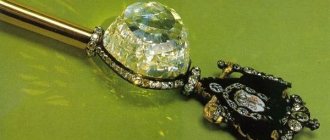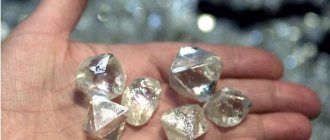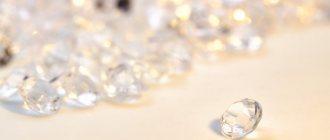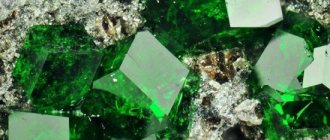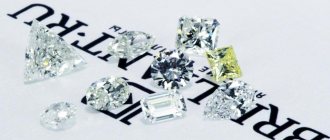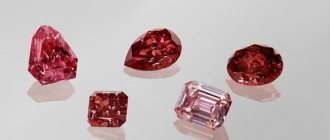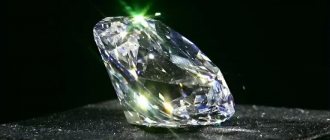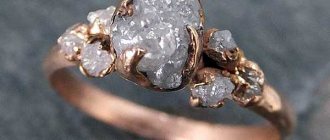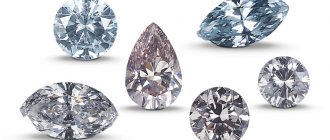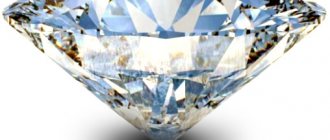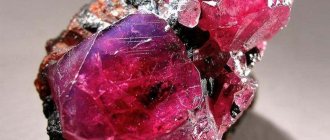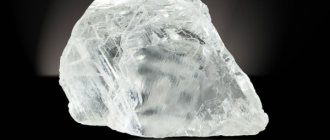Diamond is a mineral of particular hardness, the most expensive of natural gems. Some types of diamonds with bright colors are especially valued. Wine-yellow, golden, cherry and ruby stones are held in special esteem. The rarest colors of diamonds: black, purple, green.
Diamonds are mined from rocks. To obtain one carat of valuable stone, 250 tons of ore are processed.
SIZE MATTERS
The morphological characteristics of diamond are varied. Scientists distinguish poly- and monocrystalline forms of nuggets, which affect the strength of the mineral.
The mineral is so rare that large deposits can be counted on the fingers of one hand. Rich mines have 3 to 6 stones per 1 ㎥.
The weight of a diamond affects its value. Having found an apricot-sized diamond, the owner will purchase the plant with the funds received from it.
Diamonds with amazing clarity and brilliance are highly prized.
Diamond size and weight
Diamond crystals vary from microscopic (discernible only with a telescope) to large ones, the size of a fist. Researchers discovered a nugget weighing 0.63 kg (more than 3,120 carats) in the bowels of South Africa.
Diamonds weighing more than 15 carats are considered rare stones, while diamonds weighing more than 101 carats are considered rare. Often these specimens are given names.
Magic and astrology
Blue diamonds have strong energy. They can become a strong talisman for honest and worthy people.
Jewelry obtained dishonestly will only bring misfortune to the owner. She will materialize all his fears and bad thoughts, and also attract misfortune. Ultimately, the stone will drive the owner crazy.
Blue diamond is horoscope compatible with all signs except Scorpio.
It goes especially well with watermarks.
DIAMONDS ARE PRECIOUS AND NOT VERY PRECIOUS
There are the following types of diamonds:
| Jewelry | Can be processed and cut, there are no defects |
| Technical | The structure is damaged, is not used for making jewelry, they have multiple inclusions. |
It is not for nothing that diamond is considered the most expensive mineral - most of the stones are used for technical needs. Only 20% comes from jewelry. This is due to the difficulty of extracting high quality stones without inclusions.
Among a million stones, there is hardly one nugget worth the attention of jewelers. After processing, the nugget becomes half its original size: this is due to a specific cut that turns 50% of the nugget into dust.
Cut shapes
Purity of colored diamonds
For “luxury” colored diamonds, the main determining factor in value is color. Even diamonds with numerous inclusions that reduce their transparency are valued by connoisseurs if their facets have a pleasant, rich color. Of course, if inclusions somehow affect the strength of the stone, they significantly reduce its cost. Also in colored diamonds there may be color “grains”, which are also classified as inclusions.
The color and reflective grain in this light brown diamond is visible under 40x magnification.
TYPES OF CUT
Clarity and color of a diamond play a significant role in the value of a diamond, but not the key one. For a nugget to become refined and refined, the skill of the jeweler is important.
We recommend: Rose Crystal | PINK TOPAZ
In the diamond industry, it is customary to process raw materials in several stages before sending them to the shelves:
- CLEAVING THE CRYSTAL. The diamond is scanned using X-rays, in this way finding damage in it that is invisible to the human eye, which is required to facilitate cutting the diamond.
- REARING OF MINERALS using a lathe. The process is designed to form edges and corners on the stone.
- TREATMENT. The process takes place on iron polishing wheels, which are sprinkled with special diamond powder. The procedure ensures deep cutting of the mineral.
- POLISHING. A final treatment process that allows the stone to shine brighter and deeper.
Manufacturers use several shapes in the diamond cutting process. The specific design of the jewelry determines how the potential of the stones will be revealed. Any cut must meet the requirements for size and angles of inclination.
Color and purity table
The following classical methods of stone cutting are distinguished:
- ROUND. Tolkovsky's invention. Since then, the round cut has been the most popular and versatile. However, during the process the material is subjected to merciless processing, as a result of which the mineral loses most of its weight.
- PRINCESS. Square shape with sharp corners. When grinding, a minimum amount of waste is observed.
- PEAR. The sophisticated shape looks good with earrings, pendants and rings. A pear-shaped stone visually lengthens your fingers.
- MARQUISE. The elongated boat shape adds charm, aristocracy, and sophistication to a woman.
- OVAL. The oval shape of the stone creates an emphasis on the desired part of the body: ears, neckline, hands.
- HEART. Processing the heart shape requires multi-step, complex work. Therefore, such stones are more expensive than others.
- EMERALD. The shape of the stone is rectangular, with an octagonal cut. A less common option due to the extraordinary refraction of light.
- USHER. Square shape, multi-stage, with multi-tiered refraction of light.
Jewelers are working on creating other cuts, using different processing technologies.
How to decipher a tag
An expensive diamond comes with a tag with characteristics.
For example, we see on it a set of numbers and letters - 4 KR-57 0.6 3/3 B. This means:
- 4 – the number of stones in the decoration, that is, 4;
- KR - means round cut;
- 57 – number of faces;
- 0.6 – weight of the product; if there are several stones in the jewelry, then their total weight is indicated on the tag;
- 3/3 – the color and quality of the stone, that is, the 3rd position on a scale from 1 to 9 (9 are the dirtiest stones);
- B – cut level, there are four in total (A, B, C, D), A – the highest.
To read the tag in the cabin, use tables with decoding of symbols. The sales consultant has them.
COLOR PALETTE
The color of a diamond comes in all colors of the rainbow. It is affected by impurities in the diamond, as well as chemical reactions during the formation process. There are unusual colors of diamonds in nature. Among them: yellow, blue, red, green, transparent and others.
Diamond color palette
The stone without color is especially beautiful - transparent. We recommend: GREEN TOURMALINE - the magic of nature
The unusual yellow color is obtained by replacing carbon atoms with nitrogen particles. Dark yellow stones of this color range are the most valuable.
Expensive, exquisite diamonds have red, brown, and pink tints. They are mined in Australia. Scientists do not know how the stones take on an unusual color, which gives the nuggets mysticism and mystery.
Blue stones are obtained by replacing the atoms of the crystal lattice from carbon to boron. The color blue is often created in laboratories.
The color green is produced when it is influenced by radiation waves. Black nuggets are mined from the upper layers of the earth's crust, and its structure is characterized by tiny crystals fused together.
History of the fancy blue stone
Colored minerals are rare. Jewelers have learned to produce artificially colored diamonds. It is obtained by introducing boron atoms into the structure of the stone under high pressure and temperature. The natural blue mineral is found in only one deposit - in Africa.
One of the most famous natural blue stones is Hope. Its beauty and legends about it amaze with their uniqueness.
For many centuries, the blue diamond has been accompanied by mystical events and curses. It was believed that every owner of the stone would die a mysterious death. This fact was confirmed by the death of its last owner.
The history of the stone dates back to the time of the French king Louis XIV. The stone came to France from India, the temple of the god Rama. The statue of this god had a left eye made of this stone. It was sacred to Indians, punitive to all other religions. Someone stole this mineral, thereby making it cursed. The stone came to Tavernier, who was searching for jewelry for the French king. He presented it to Louis.
The mineral was a rare type of colored diamond with a deep blue color. When it came to France, it had a triangular shape and was poorly cut. Its weight was 115 carats. Louis commissioned experienced cutters to correct the shape and cut. The stone took on the shape of a heart and began to weigh almost half as much, but all its beauty was revealed. He shone with inner fire, with all his facets. People even started talking about his beauty outside of France.
- The curse of the stone began to operate in Europe from its first owner. Historians have established that the first victim was Tavernier. He traveled a lot around the world, looking for jewelry and minerals for the king. On one of these expeditions he was torn to pieces by a pack of hungry dogs.
- According to another version, the appearance of the stone in Europe led to a plague epidemic that killed many people.
- For many years, King Louis of France had a favorite - the Marquise de Montespan. During this time, she gave birth to eight children to the king, for which he gave her a diamond. The king's feelings quickly cooled after this gift, and the marquise was expelled from the palace. The diamond returned to the palace again.
- The king did not part with him for six months, after which he died. Misfortunes befell the entire Bourbon family. One by one, all the adult heirs of the king died. The throne went to a five-year-old child, his great-grandson.
- For many years the diamond lay in the royal treasury. No one touched it; it was known as a cursed stone. The young king grew up, the fear of the curse passed. He wanted to give it to his favorite Madame DuBarry. She came from a simple family and shone with her beauty. But the stone did not bring her happiness. She was soon removed from the palace, and during the French Revolution she was beheaded by guillotine.
- At one of the balls, the king attached the famous diamond to his ceremonial costume, inserting it into the cross of the golden fleece. The Seven Years' War began. She exhausted the strength of France, her influence in the world weakened. Ten years later the king died.
- A tragic fate followed the next Louis XIV and his wife, who tragically ended their lives. Later, the treasury was looted and the stone disappeared for some time.
- It was divided into several parts. This did not save the owners from death. They were all killed. A bloody rumor haunted the stone.
- The largest part of the diamond (14 carats) went to a famous jeweler. The stone disappeared and was considered lost. It turned out that it was stolen by his son. The father died of grief, the son committed suicide.
- In 1820, the stone fell on the soil of England. Henry was known as an intelligent, educated monarch, knew many foreign languages, loved music, and played musical instruments. After he bought this diamond, his life changed dramatically. Many believed that the monarch had gone crazy. He became interested in wine and indulged in endless entertainment that ended in drunken orgies.
- The stone was purchased by a man named Hope. He named the stone after himself. The translation of his last name means “hope”. But this did not help change the curse. Hope died of an unknown illness. His heirs also suffered: his son was killed, his grandson went bankrupt.
- The stone left its mark on the history of Russia. One of the small pieces was inserted into the ring of Tsarina Maria Feodorovna (the Dowager Empress). Now this stone is in the Diamond Fund of St. Petersburg.
- At the beginning of the last century, an aristocrat from Russia gave a large diamond to his mistress (ballerina Ledue). Having found her with her lover, he killed her out of jealousy. He hid for many years and was also killed.
- Another mistress died because of a diamond, who was given the stone by the Sultan of Egypt. After he killed his mistress out of jealousy, he was expelled from the country.
- A tragic page in life that was influenced by the stone is the sinking of the Titanic. One of the small pieces of the diamond belonged to a married couple who were traveling on a ship. They died tragically in this crash.
- The main stone went through many more owners until it came to the jeweler Pierre Cartier. The famous jeweler set it in a necklace surrounded by colorless diamonds. They said that it was he who came up with the story of the curse of the diamond in order to increase its price.
- The famous American woman was amazed by the beauty of the necklace and bought it for a lot of money. She didn’t believe the curse story, but before putting it on, she blessed the necklace in the church. The diamond attracted the woman with its beauty. She practically never parted with him. I wore it to all sorts of events and let my little son play with it. A little time passed, the curse began to take effect. My husband went crazy due to constant drinking. He ended his life in a madhouse. A child who was playing with a necklace died when he was very young under the wheels of a car. The daughter died from an overdose of sleeping pills.
- The heirs of the diamond paid off their debts with the diamond. The stone came to Henry Winston, who did not believe that the gem brings bad luck. He held exhibitions where he showed the “cursed diamond.” He donated the proceeds to charity. Then he donated the diamond to the Washington Institute. He sent it with an ordinary messenger, who became the last victim of the diamond. A man died under the wheels of a truck, and his family died in a fire.
To this day it is in the museum. This unique mineral with its “bloody history” still has a magical effect on everyone who was able to see it.
According to one version of the origin of diamonds, it is believed that they came from meteorites from other civilizations. Maybe it is this fact that gives the mineral magical power and power over the human mind.
SYNTHETIC AND NATURAL
- Jewelers have learned to create synthetic crystals - these are fancy colored diamonds, the shade of which depends on laboratory experiments.
- A synthetic diamond is an exact copy, similar to the original. The structure, properties and other indicators do not differ from those of natural minerals.
- Synthesized diamonds are superior to natural diamonds in terms of hardness, purity, and are better cut.
- Artificial stones are pleasing with the complete absence of defects, unlike their “brothers” (microcracks, inclusions, clouding). At the same time, man-made specimens are cheaper than natural diamonds.
- In connection with the process of obtaining synthetic stones, the names of diamonds have been replenished with new laboratory developments. The first artificial stone was produced in 1950 in Sweden.
Unlike natural stones, synthetic ones are without flaws, but are several times cheaper than natural ones.
Diamond classification
At the everyday level, it is believed that the main advantage of a diamond is its weight. Professionals evaluate comprehensively, according to the international 4C system. Cut, clarity, weight, color are taken into account (from the English cut, clarity, carat, color).
Cut
It is the cut that turns a dull diamond into an expensive sparkling diamond. Its type is chosen based on the shape, size, and quality of the pebble. Good work neutralizes flaws, emphasizes advantages, and preserves the original weight of the stone as much as possible.
More often, the crystal is cut classically - round diamonds with 57 facets (KR57) are beautiful. This is how many facets there should be on a stone over 0.3 carats. Very large expensive specimens are cut with values of 74, 86, 102; for small ones, an option with 17 facets is acceptable.
Fancy shapes such as heart, pear and marquise are popular.
Purity
The degree of purity determines how the stone reflects sunlight. According to the GIA classification, there are 11 purity groups - from IF (without flaws) to I3 (imperfect).
The Russian scale is different. A 9-point scale determines the purity of stones up to 0.29 carats inclusive; a 12-point scale evaluates crystals heavier than 0.3 carats. At the same time, 1 is the highest purity, 12 is the lowest-grade stones with significant inclusions.
Pebbles up to the seventh level are considered a good choice, so if finances are limited, choose a specimen from the “golden” mean based on purity.
Color
Almost all crystals are transparent or yellowish. According to international gradation, they are assigned a sign - from D to Z, indicating the degree of transparency and yellowness.
D is for “pure water diamonds.” Starting from H, the stones have a yellowish tint, which is visually distinguishable. Popular colors among Europeans are 4 and 5 (J and H).
In Russia, color is classified into 9 groups, from 1st – absolutely colorless diamonds to 9th – specimens with a pronounced yellow or brown tint. The price difference between them is two to three times. The best-selling stones are level 3–5, but it is impossible to determine by eye whether it is level 3–4 or level 4–5. It’s worth thinking about whether it makes sense to overpay.
For “white” crystals, the degree of colorlessness is valued. People of color are classified according to their color groups and subgroups. The characteristic includes the term fancy (that is, fantasy), a description of color and its saturation. Colored stones are usually cheaper. But bright, fancy blues, yellows, and greens are rare. They are considered the best, valued many times over, and sometimes an order of magnitude higher than classic colorless diamonds.
Weight
The Russian system is similar to the world one. Diamonds are weighed in carats to the second decimal place - one carat is equal to 0.2 grams.
Crystals according to this parameter are divided into categories (in carats):
- up to 0.29 – small;
- up to 0.99 – average;
- from 1.00 – large.
The weight of a stone in jewelry is calculated using special formulas. Knowledgeable people advise taking 0.99-carat copies. Visually, they are indistinguishable from one-carat ones, but are significantly cheaper.
Popular jewelry diamonds range from 0.30 to 1.00 carats. One-carat stones are used for rings, and smaller ones are used to decorate earrings.
Fluorescence
A high fluorescence rate reduces the cost of the stone by a third. Such specimens are identified by their luminosity in ultraviolet light.
Magic properties
Diamond is a stone with very strong positive energy. With its help, the owner’s aura is strengthened - this is the main meaning of a diamond for a person.
The diamond nugget is considered a symbol of innocence, courage and toughness.
The character of this stone is capricious. He belongs to the element of Fire and does not like people whose zodiac sign is associated with the element of Water.
His attitude towards others is peculiar: he enhances a person’s positive qualities and punishes negative qualities. If, after you got a diamond, a streak of troubles began, you should think: maybe you are not as good a person as you think.
If the owner of the gem is a kind, generous, self-confident person, the diamond will become his faithful assistant. It is believed that it will help you find true love, good luck in all matters, and ensure prosperity and long life.
Diamond is a powerful amulet that protects against any evil. If a sorcerer wants to harm a person, then the mineral will bring down all these misfortunes on the sorcerer himself.
In ancient times, it was believed that this nugget protected against attacks by wild animals.
Diamond is considered one of the powerful love talismans, so diamond jewelry is very suitable for an engagement or wedding.
Esotericists believe that this stone reveals its magical properties only if it is given as a gift or inherited. A diamond manifests its magical properties in full force only 7 years after a person begins to wear it.
Medicinal properties
Diamond and diamond have a general healing effect on the body.
They help with many diseases, but when using them for this purpose, one should not neglect the treatment prescribed by the doctor.
This stone has a positive effect on many diseases, for example:
- for diseases of the stomach and liver;
- heart problems;
- diseases of the lower respiratory organs.
In addition, it produces a sedative effect.
Diamond jewelry promotes mental clarity and good health.
Blue or green diamond is believed to be beneficial for pregnant women.
Physicochemical characteristics
Scientists began exploring diamond in the 18th century . Its main distinctive features are revealed. Diamond Characteristics:
- It consists of pure carbon, that is, it is a nugget. Chemical formula - C.
- Durable under normal conditions. In a vacuum or in an inert gas at high temperatures it turns into graphite. Interestingly, diamond is the hardest mineral, and graphite is the softest. The reason for this is that the shape of the crystal lattice of diamond is cubic, while that of graphite is layered.
- Increased hardness (10 on the Mohs scale) is combined with fragility.
- Highest modulus of elasticity and compression ratio. It is impossible to compress a diamond, only crush it.
- Color - colorless, brown, yellow, blue, blue, green, pink, red, black.
- Luster - diamond (in black stone - satin or weak diamond).
- Transparency - transparent (black diamond - translucent or opaque).
- The cleavage is perfect.
- The fracture is conchoidal to splinter-like.
- Density (specific gravity of diamond) - 3.47–3.55 g/cm3 .
- Diamond stroke color is missing.
Optical properties of diamond:
- The refractive index of light is 2.417–2.419 (the highest among all gemstones).
- The dispersion of the optical axes is strong.
- Luminescence is an important property of this mineral. Even an uncut stone in the sun and rays close to it in the spectrum plays with different colors (red, yellow, green, blue). This helps to look for nuggets in diamond-bearing veins.
The shapes of diamond crystals are very diverse; they are divided into 2 groups : flat-sided and curved crystals.
How color is formed
To find out how the color of a mineral is formed, you need to study its composition. 99% of the mineral is pure carbon, 1% is various inclusions and impurities. Such impurities are most often chromium, boron, as well as manganese, silicon, etc. It is this 1% of impurities that is responsible for the color of the stone. Since pure carbon is transparent and colorless.
Finding a pure stone without impurities is a great success. Pure diamonds practically do not exist in nature. Therefore, unscrupulous jewelers and other entrepreneurs often pass off other similar minerals as a pure diamond: rock crystal, as well as leucosapphire and white topaz.
The amount of impurities in minerals is responsible for the color saturation, since these inclusions are only 1%, and the colors of the diamond are usually pale, pastel. Ultraviolet radiation also affects color formation.
Sometimes diamonds are multi-colored, which means they contain different impurities.
